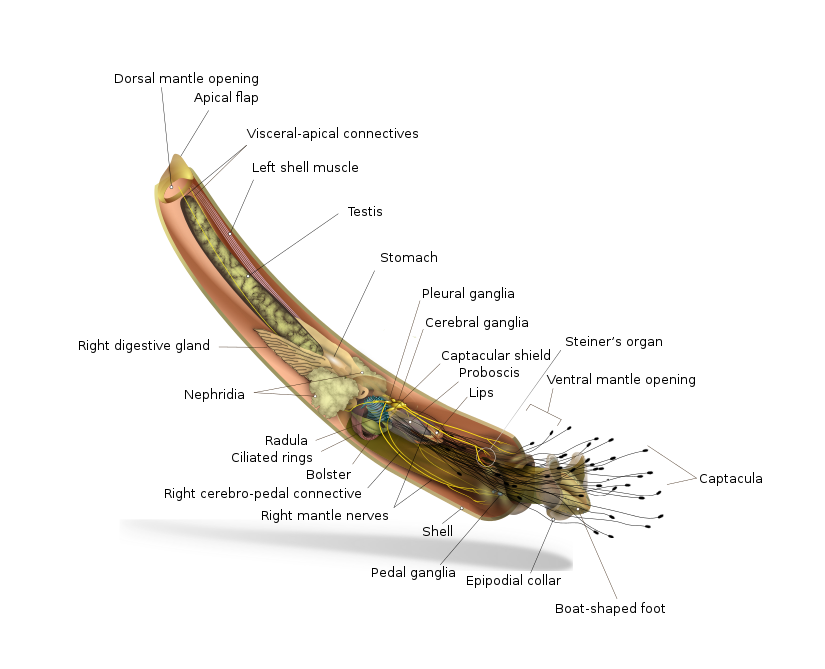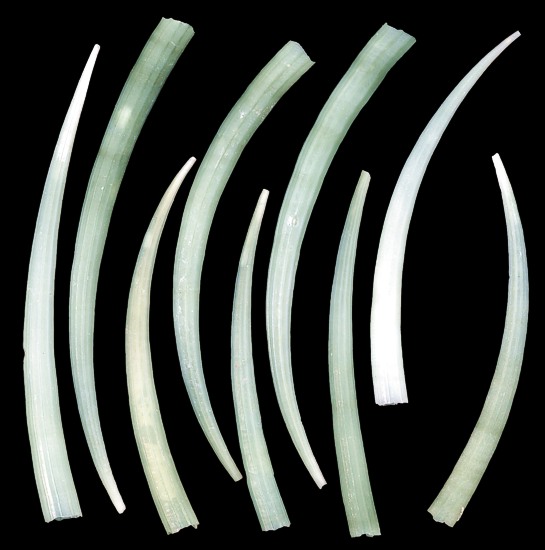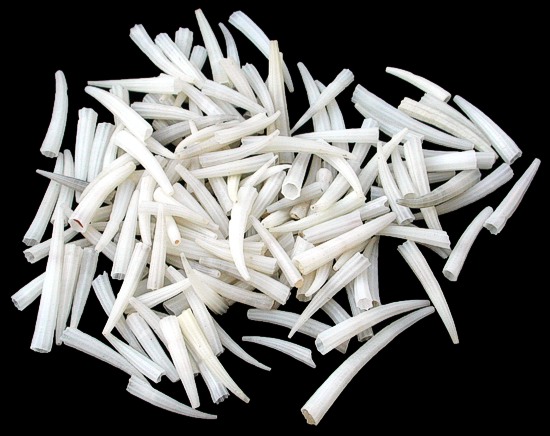Tusk Shells
The tusk shells or tooth shells, Scaphopoda, are members of a class of marine mollusks with worldwide distribution, and are the only class of exclusively infaunal (Aquatic animals, such as clams or burrowing worms, that live beneath the surface of the sea) mollusks. Species within this class range from about 1/4 to 7 inches in length. Members of the order Dentaliida tend to be larger than those of the order Gadilida.
Tusk shells live in soft substrates offshore (usually not intertidally).
Gadilida shells are usually glassy-smooth and narrow, with a reduced aperture. This along with other structures of their anatomy allows them to move with surprising speed through loose sediment to escape potential bottom-dwelling predators.
Dentalids tend to have strongly ribbed and rough shells. When they sense vibrations anywhere around them, their defensive response is to freeze. This makes them harder to detect by animals such as ratfish, which can sense the electrical signals given off by the most minute muscle movement.
The scaphopod mantle is entirely within the shell. The foot extends from the larger end of the shell, and is used to burrow through the substrate. The scaphopod positions itself head down in the substrate, with the apical end of the shell (at the rear of the animal's body) projecting upward. This end seldom appears above the level of the substrate, however, as doing so exposes the animal to numerous predators. Most adult scaphopods live their lives entirely buried within the substrate.
Water enters the mantle cavity through the apical aperture, and is wafted along the body surface by cilia. There are no gills; the entire surface of the mantle cavity absorbs oxygen from the water. Unlike most other mollusks, there is no continuous flow of water with a separate exhalant stream. Instead, deoxygenated water is expelled rapidly back through the apical aperture through muscular action once every ten to twelve minutes.
A number of minute tentacles around the foot, called captacula, sift through the sediment and latch onto bits of food, which they then convey to the mouth. The mouth has a grinding radula that breaks the bit into smaller pieces for digestion. The radulae and cartilaginous oral bolsters of the Gadilidae are structured like zippers where the teeth actively crush the prey by opening and closing on it repeatedly, while the radulae and bolsters of the Dentaliidae work rachet-like to pull the prey into the esophagus, sometimes whole.
The large radula of the scaphopods is the largest such organ relative to body size of any mollusk (among whom, except for the bivalves, the presence of a which is a defining characteristic). The remainder of the digestive system consists of a digestive diverticulum, esophagus, stomach, and intestine. A digestive gland secretes enzymes into the stomach, but, unlike some other mollusks, does not digest the food directly itself. The anus opens on the ventral/ underside of the animal, roughly in the middle of the mantle cavity.
The scaphopod vascular system is lacks heart auricles as well as corresponding ctenidia (gills) and blood vessels; the blood is held in sinuses throughout the body cavity, and is pumped through the body by the rhythmic action of the foot. The heart, a characteristic feature of all other groups of mollusks, has been considered totally lost or reduced to a thin fold of the pericardium; however, according to more recent studies, the muscular, regularly beating perianal blood sinus is homologous to the ventricle and is therefore considered the scaphopod heart.
Metabolic waste is excreted through a pair of nephridia close to the anus. The tusk shells appear to be the only extant mollusks which completely lack the otherwise standard molluscan reno-pericardial apertures. They also appear to be the only mollusks with openings that directly connect the hemocoel with the surrounding water (through two "water pores" located near the nephridial openings). These openings may serve to allow the animal to relieve internal pressure by ejecting body fluid (blood) during moments of extreme muscular contraction of the foot.
The nervous system is generally similar to that of cephalopods. One pair each of cerebral and pleural ganglia lie close to the oesophagus, and effectively form the animal's brain.
A separate set of pedal ganglia lie in the foot, and a pair of visceral ganglia are set further back in the body, and connect to pavilion ganglia via long connectives. Radular and sub-radular ganglia are also present, as are statocysts with staticonia. Scaphopods have no eyes, no osphradia, or other distinct sensory organs. However, scaphopods do possess genes involved in photoreceptor formation and function implying scaphopods may have had eyes that degenerated over evolutionary time.
Scaphopods have separate sexes, and external fertilization. They have a single gonad occupying much of the posterior part of the body, and shed their gametes into the water through the nephridium.
Once fertilized, the eggs hatch into a free-living trochophore larva, which develops into a veliger larva that more closely resembles the adult, but lacks the extreme elongation of the adult body. The three-lobed foot originates prior to metamorphosis while the cephalic tentacles develop post metamorphosis. Scaphopods remain univalve throughout their morphogenesis contrary to bivalves.
Tusk shells live in seafloor sediment, feeding primarily on single cell organisms, some supplement this with vegetable matter.
Scientific classification
Domain: Eukaryota
Kingdom: Animalia
Phylum: Mollusca
Subphylum: Conchifera
Class: Scaphopoda
Bronn, 1862
(REF: Steiner, G. (1992). "Phylogeny and Classification of Scaphopoda". Journal of Molluscan Studies.) (REF:Reynolds, Patrick D. (2002). "The Scaphopoda". Molluscan Radiation - Lesser-known Branches. Advances in Marine Biology. Vol. 42 ) (REF: Guralnick, R.; Smith, K. (1999). "Historical and biomechanical analysis of integration and dissociation in molluscan feeding, with special emphasis on the true limpets (Patellogastropoda: Gastropoda)". Journal of Morphology. 241 ) (REF: Wanninger, Andreas; Haszprunar, Gerhard (2001). "The expression of an engrailed protein during embryonic shell formation of the tusk-shell, Antalis entalis (Mollusca, Scaphopoda)". Evolution & Development.3)(REF: Wollesen, Tim; McDougall, Carmel; Arendt, Detlev (2019-10-19). "Remnants of ancestral larval eyes in an eyeless mollusk? Molecular characterization of photoreceptors in the scaphopod Antalis entalis". EvoDevo. 10)


Green Tusk Shells
The tusk shells or tooth shells, technically the Scaphopoda are members of a class of shelled marine mollusca with worldwide distribution, and are the only class of exclusively infaunal marine molluscs. Shells of species within this class grow from about 1/2 to 7 inches in length. Members of the order Dentaliida tend to be larger than those of the order Gadilida.
These molluscs live in soft substrates offshore (usually not intertidally).
Tusk shells live in seafloor sediment, feeding primarily on foraminiferans; some supplement this with vegetable matter.
According to Shimek and Steiner, "[the apex of the shell and mantle are anatomically dorsal, and the large aperture is ventral and anterior. Consequently, the concave side of the shell and viscera are anatomically dorsal. The convex side has to be divided into anteriorly ventral and dorsally posterior portions, with the anus as the demarcation. Functionally, as in cephalopods, the large aperture with the foot is anterior, the apical area posterior, the concave side dorsal and the convex side ventral."
he shells of the members of the Gadilida are usually glassy-smooth and narrow, with a reduced aperture. This along with other structures of their anatomy allows them to move through loose sediment to escape potential bottom-dwelling predators.
The Dentalids, by contrast, tend to have strongly ribbed and rough shells. When they sense vibrations anywhere around them, their defensive response is to freeze. This makes them harder to detect by animals such as ratfish, that can sense the electrical signals given off by the most slightest muscle movement.
The mantle of a scaphopod is entirely within the shell. The foot extends from the larger end of the shell, and is used to burrow through the substrate. The scaphopod positions itself head down in the substrate, with the apical end of the shell (at the rear of the animal's body) projecting upward. This end seldom appears above the level of the substrate, however, as doing so exposes the animal to numerous predators. Most adult scaphopods live their lives entirely buried within the substrate.
Water enters the mantle cavity through the apical aperture, and is wafted along the body surface by cilia. There are no gills; the entire surface of the mantle cavity absorbs oxygen from the water. Unlike most other mollusks, there is no continuous flow of water with a separate exhalant stream. Instead, deoxygenated water is expelled rapidly back through the apical aperture through muscular action once every ten to twelve minutes.
A number of tiny tentacles around the foot, called captacula, sift through the sediment and latch onto bits of food, which they then convey to the mouth. The mouth has a grinding radula that breaks the bit into smaller pieces for digestion. The radulae and cartilaginous oral bolsters of the Gadilidae are structured like zippers where the teeth actively crush the prey by opening and closing on it repeatedly, while the radulae and bolsters of the Dentaliidae work rachet-like to pull the prey into the esophagus, sometimes whole.
The large radula of the scaphopods is the largest such organ relative to body size of any mollusc (among whom, except for the bivalves, the presence of a which is a defining characteristic). The remainder of the digestive system consists of a digestive diverticulum, esophagus, stomach, and intestine. A digestive gland secretes enzymes into the stomach, but, unlike some other molluscs, does not digest the food directly itself. The anus opens on the ventral/ underside of the animal, roughly in the middle of the mantle cavity.
The scaphopod vascular system is rudimentary lacking heart auricles as well as corresponding ctenidia (gills) and blood vessels; the blood is held in sinuses throughout the body cavity, and is pumped through the body by the rhythmic action of the foot. The heart, a characteristic feature of all other groups of mollusca, has been considered totally lost or reduced to a thin fold of the pericardium; however, according to more recent studies, the muscular, regularly beating perianal blood sinus is homologous to the ventricle and is therefore considered the scaphopod heart
Metabolic waste is excreted through a pair of nephridia close to the anus. The tusk shells appear to be the only extant mollusks which completely lack the otherwise standard molluscan reno-pericardial apertures. Furthermore, they also appear to be the only mollusks with openings that directly connect the hemocoel with the surrounding water (through two "water pores" located near the nephridial openings). These openings may serve to allow the animal to relieve internal pressure by ejecting body fluid (blood) during moments of extreme muscular contraction of the foot.
Scaphopods have separate sexes, and external fertilisation. They have a single gonad occupying much of the posterior part of the body, and shed their gametes into the water through the nephridium.
Once fertilized, the eggs hatch into a free-living trochophore larva, which develops into a veliger larva that more closely resembles the adult, but lacks the extreme elongation of the adult body.[10] The three-lobed foot originates prior to metamorphosis while the cephalic tentacles develop post metamorphosis. Scaphopods remain univalved throughout their morphogenesis contrary to bivalves.
Scientific classification
Domain: Eukaryota
Kingdom: Animalia
Phylum: Mollusca
Subphylum: Conchifera
Class: Scaphopoda
(REF: "dentalium". Oxford English Dictionary (Online ed.). Oxford University Press. ) (REF: MolluscaBase eds. (2020). MolluscaBase. Dentalium Linnaeus, 1758. Accessed through: World Register of Marine Species)(REF:Habe, T. (1963). A classification of the scaphopod mollusks found in Japan and adjacent areas. Bulletin of the National Science Museum Tokyo.)(REF: Gofas, S.; Le Renard, J.; Bouchet, P. (2001). Mollusca. in: Costello, M.J. et al. (eds), European Register of Marine Species: a check-list of the marine species in Europe and a bibliography of guides to their identification. Patrimoines Naturels. 50)(REF: Leach, B. F. (1977). Dentalium shell in New Zealand archaeological sites. Journal of the Royal Society of New Zealand, 7)
PP1-7
One Green Tusk Shell 2 to 2 6/8 inches......OUT OF STOCK

White Tusk Shells
This species is called the White Tusk, a gastropod; family Dentaliida; class Scaphopoda. Like other Tusks it is elongated and tapered. It is a thin,and sometimes shiny shell that is slightly curved . Other than a few growth rings, the shell is almost smooth. In older species, the shell has fine longitudinal lines. Its color is white to a grayish tinge. The White Tusk is found in the Indo-Pacific region, ranging from eastern Africa to the northern shores of Australia/New Zealand Then North to just south of the Sea of Japan. These are strictly a salt water species. Their shell has an opening at each end. Tusks prefer sandy or muddy ocean floors, where they burrow into the sand with their small end up. The tusks have been found in tidal zones and water several hundred feet deep. These are not commonly found.
Scientific classification
Domain: Eukaryota
Kingdom: Animalia
Phylum: Mollusca
Class: Scaphopoda
Order: Dentaliida
Family: Dentaliidae
Genus: Dentalium
Linnaeus, 1758
(REF:MolluscaBase eds. (2020). MolluscaBase. Dentalium Linnaeus, 1758. Accessed through: World Register of Marine Species ) (REF: Habe, T. (1963). A classification of the scaphopod mollusks found in Japan and adjacent areas. Bulletin of the National Science Museum Tokyo. 6)(REF:Scarabino V., (1995) Scaphopoda of the tropical Pacific and Indian Oceans, with description of 3 new genera and 42 new species ) (REF:Gofas, S.; Le Renard, J.; Bouchet, P. (2001). Mollusca. in: Costello, M.J. et al. (eds), European Register of Marine Species: a check-list of the marine species in Europe and a bibliography of guides to their identification. Patrimoines Naturels. 50 )
P2-7
One Ounce of White Tusks 1/2 to 1 inch ...... .69